Out in the middle of the north-west New Territories is the MTR Light Rail network: it is a very different system to the double deck trams on Hong Kong Island, which is the trams that tourists usually see. The route map shows how complex it is!
Running between the New Towns of Tuen Mun and Yuen Long, the system was built by the Kowloon-Canton Railway Corporation, commencing operation in 1988 to serve the then-developing suburbs. The network originally served as the main transport system in the area, but with the opening of the West Rail Line in 2003, the network of routes was rearranged to serve as a feeder system to the new railway.
Single car light rail vehicles (LRVs) are used, but they can be operated as coupled pairs. They use standard gauge (1435 mm) track and 750V DC electrification: the standards used on most modern light rail networks. There are four different ‘phases’ of LRV that look slightly different but have the same general design: I’ll go into rolling stock further in a future post.
The majority of the network is double track and separated from traffic, running at grade, usually on one side of the road. Left hand running is always used, except for the complicated track at a few termini.
Level crossings are usually traffic light controlled.
A few sections run down the middle of the road in reserved track: this is on Castle Peak Road in Yuen Long.
A small proportion of track runs on viaducts: this is the approach to Tuen Mun station.
Street running with paved tracks seems to be very rare: I found this piece of single track at Yau Oi, which is the terminus of route 751.
All LRVs on the network are single sided, with all doors belong located on the left hand side.
High level platforms are provided at all light rail stops, providing step free access to the high floored LRVs. Virtually all stops have side platforms: the single sided doors rule out island platforms except where complicated track arrangements exist.
For the same reason each terminus needs a balloon loop to get the LRV facing the right way for the return journey. Some loops are tight like this one, others (like the one at Yau Oi mentioned earlier) take an easier route by running around the block.
The curves on the network seem to be rather extreme for something 30 years old and built in a modern city. This is the exit from Yuen Long station, and yes, these two trams are still coupled together!
The majority of intersections are ‘T’ shaped, with full triangular junctions. (no grand unions unfortunately). I found it interesting that “V-Tag” automatic points are provided at the facing points: this is the same system used in Melbourne. The indicator on the right has ‘horizontal’ (pending operation), ‘left facing’ (turn left) and ‘right facing’ (turn right) indicators: the only difference seems to be that the ‘horizontal’ indicator is red instead of white.
The only other signalling I found on the network was ‘T’ lights at intersections. A red ‘T’ indicates stop, while a white upward arrow indicates proceed.
LRVs close in on each during peak times, with nothing stopping them.
At each light rail stop the time until the next service is displayed, the screens are also nice enough to tell you whether a single LRV or a coupled pair is coming along. The final cherry on top is the alternating English and Chinese text – they do everything!
Fares can be paid in two ways. A single trip ticket can be purchased from the ‘Single Journey Ticket Issuing Machine’. First you need to work out what zones you are going to pass through. Then push the button corresponding to the first zone, then push the “+” button to add any additional zones. Full and concession fares have an entirely different set of zone buttons – the network map does not make the machine look any less complex!
The other option is using an Octopus card. At each stop ate two fare processors: orange processors are used to ‘touch on’ before boarding a LRV, green processors are for ‘touch off’ on leaving.
To ensure compliance with the open barrier system, MTR staff travel the network, waiting on platforms with Octopus card readers to ensure passengers leaving have actually validated their card on entering the system. Within 1 hour I saw inspectors at three different locations, so it appears they do not mess about. An interesting passage from the MTR website relating to the open fare system:
The primary objective of ticket inspections is to ensure that honest, fare-paying passengers do not have to subsidise fare evaders.
Passengers found without a validated Octopus Card or a valid single trip ticket don’t get fined, but just pay a “surcharge” – set at 50 times the maximum adult single fare!
In all, the Light Rail network seems to be an odd mix of the modern systems seen in Europe, combined with ‘old fashioned’ single car high floored trams. The rolling stock also has a connection to Melbourne’s Z class trams and the Comeng factory at Dandenong, but that is a story for another day…




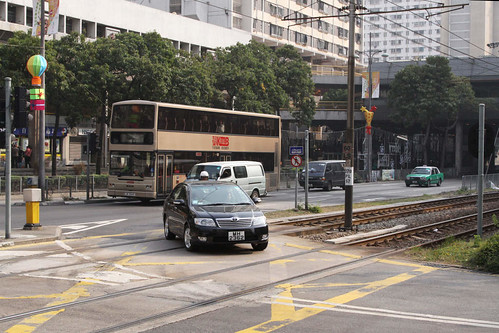


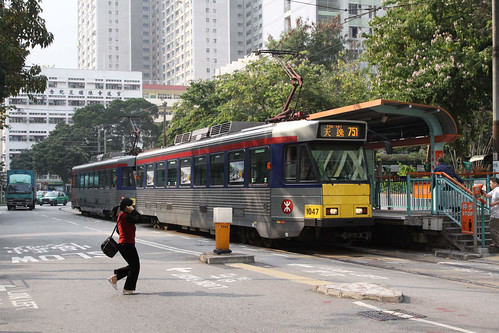
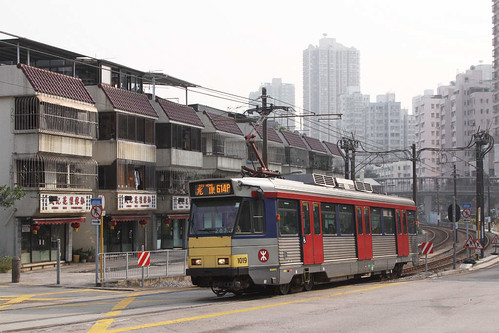
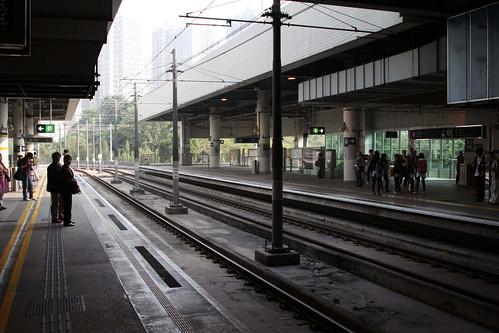
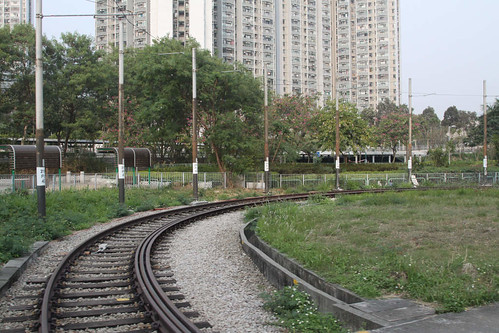
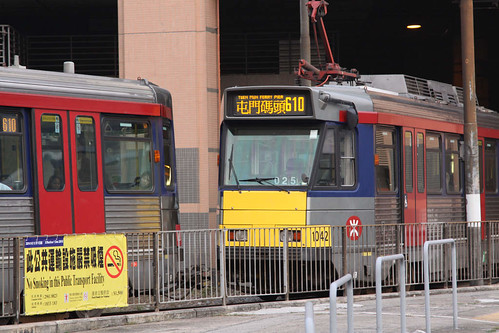
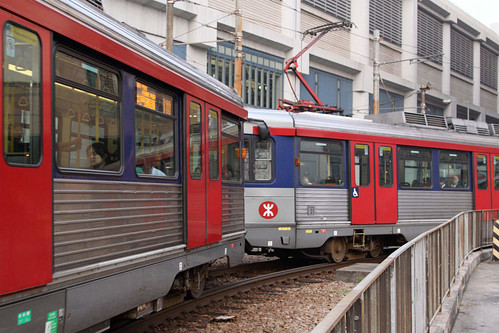
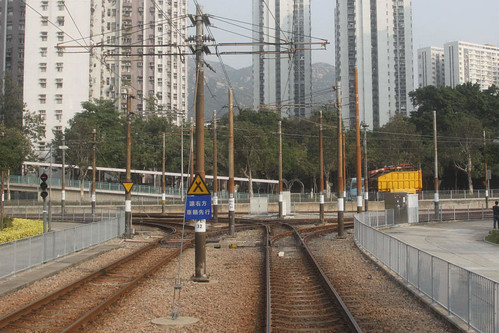
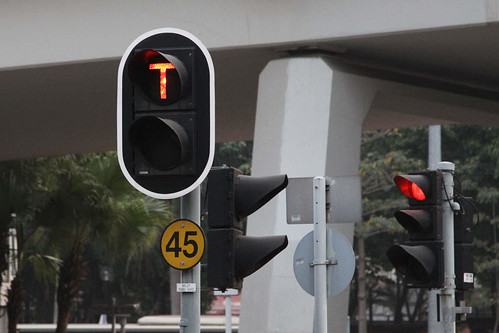
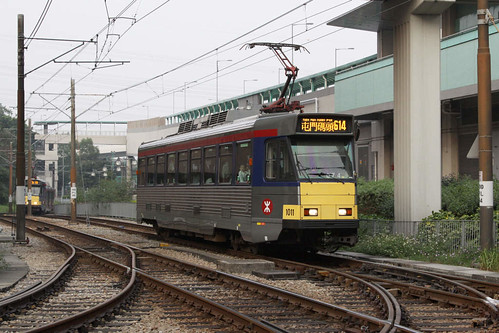
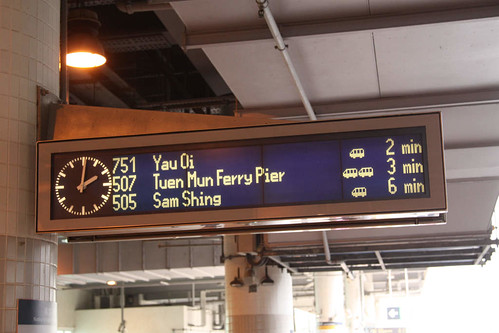
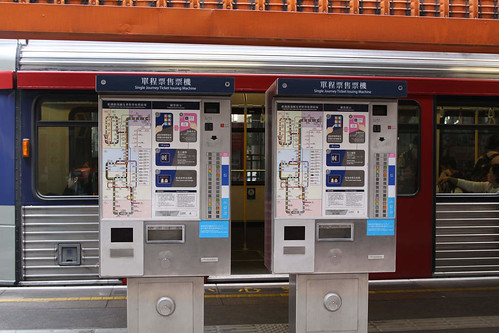
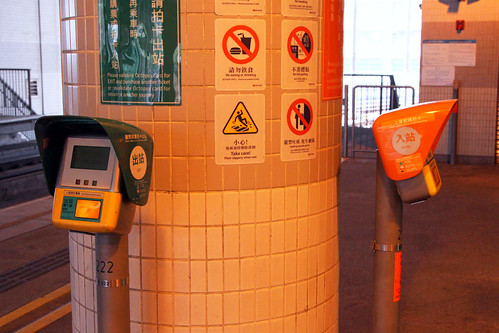
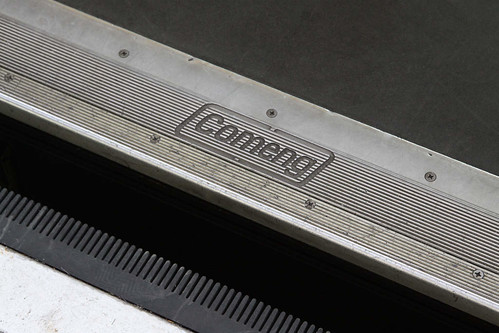

Pingback: MTR Light Rail: rolling stock | Checkerboard Hill
Pingback: Operations on the Hong Kong Tramways | Checkerboard Hill
Pingback: Melbourne and Hong Kong trams: long lost siblings | Checkerboard Hill
Pingback: Hong Kong railways *do* have level crossings | Checkerboard Hill
Pingback: Public safety advertisements and the KCR Light Rail | Checkerboard Hill
One thing I have noticed from photos is the use of centre poles on all sections of track, what puzzles me is why they don’t resort to span poles on curves as they would be better at accomodating the swing of rail vehicles. Track centres wouldn’t need to be increased as much on curves if span poles were in place.
The widespread use of span poles with tight corners at triangular junctions is an odd design feature seen across the Light Rail system.
Note that the original system was designed and constructed for the Kowloon Canton Railway Corporation by an Australian joint venture – Comeng, Leighton, and the Metropolitan Transport Authority (successor of the Melbourne and Metropolitan Tramways Board, predecessor of the Public Transport Corporation).
The book ‘Comeng: A History of Commonwealth Engineering Volume 5, 1985-2012, Volume 5‘ has a lot more on the topic.
I found a track map of the network, and there is a short section of quadruple track. Do you know anything about it? Also, there is a photo showing a juction that appears to have no signals apart from points indicators. Are all other junctions, including to intermediate loops, protected by T lights like you mentioned. As far as I know, most newbuild light rail is driven on sight with all conflicts dictated by signalling.
The four track section is for the tram stop at Tuen Mun Town Centre:
http://en.wikipedia.org/wiki/Town_Centre_Stop
Six routes pass through the stop so there are four platforms. Due to the LRVs only having doors on one side, there are four side platforms – no island platforms. The side tracks rejoin the mainline soon after.
There are also a few short sections of triple track around the network – located at busy junctions, they separate out the turning and straight through movements to avoid delays:
https://www.google.com.au/maps/@22.3959835,113.9673754,3a,75y,193.22h,73.41t/data=!3m4!1e1!3m2!1sz1AQityoyq-uUFPIR_yhfQ!2e0
From what I saw, the ‘T’ lights are only used at road intersections, to allows cars free access across the tracks. All rail-to-rail conflict points such as junctions and reversing loops appear to have no signals – just point indicators.
It seems a little wierd that you only have conflict protecting signals at road intersections but not at track juctions, are the LRVs not scheduled (according to the timetable) to arrive at a given junction within the same timeframe?
Here in Melbourne, most junctions, apart from crossovers, depot and siding entrances, and termini covergence, are signal controlled. I believe that many of the world tram systems, especially newer ones, have conflict protecing signals at all juctions including crossovers.
However in Melbourne signal control at junctions is usually due to the tracks being located on public roads, which are already subject to traffic signals for motor vehicles.
They usually follow normal rules at an all Give Way intersection, following the right of way rule for normal intersections.
The first time I took the LRT I was surprised that it did not have traffic light priority, I wonder why they didn’t design it with priority.
I haven’t used it but noticed that many junctions aren’t signal controlled. Standard LRT practice, especially on newbuild, is to put signals at all juctions, including crossovers.
Possibly the Australian influence is to blame for this. The first stage of the Tuen Mun Light Rail was designed and built by an Australian consortium – Leighton Contractors doing the civil work, Comeng building the rolling stock, and Melbourne’s Metropolitan Transport Authority providing the tramway knowledge.
The book “Comeng: A History of Commonwealth Engineering Volume 5, 1985-2012, Volume 5” gives a very detailed history of how the system was designed and built for the KCR.
They do have traffic light priority. To quote the Wikipedia page (香港輕鐵),
“when an LRV reaches within 100 meters of a level crossing or traffic signal controlled junction, the vehicle will emit a signal towards the receiver on the rails, the receiver will then send the signal to the computer system in the traffic light control box, allowing the traffic lights to coordinate, prioritising the LRV”.
The only problem is that it may cause heavier-than-usual congestion in crowded areas like Tin Shui Wai and Yuen Long, which is why this priority is not absolute. However, at low traffic locations, for example, the stretch of track from Pui To to Fung Tei, serviced by 614 and 614P, LRVs are indeed prioritised and can be easily observed.
Thanks for that. Sounds like the same problem that exists in Melbourne – the technology to detect the presence of trams exists, but those in charge want to keep cars moving instead, so don’t give them priority.